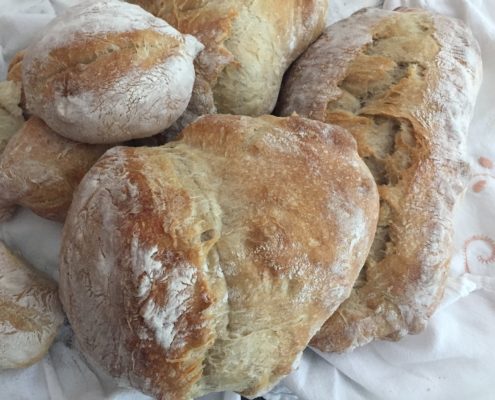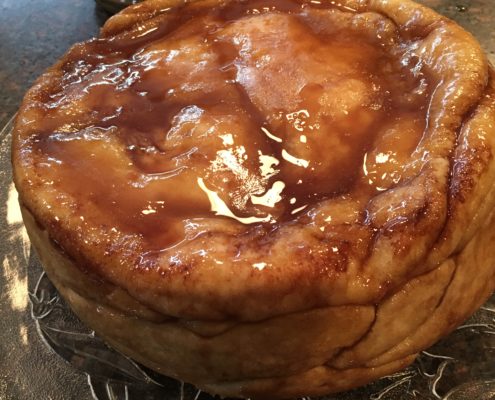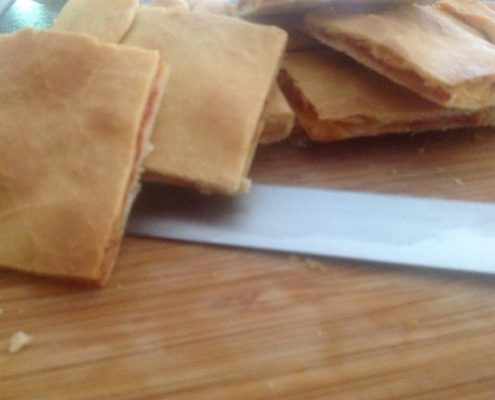The Making of Rustic Bread at Home
The aroma of freshly baked bread filling the senses gives a calming effect. Bread baking is fairly easy and you need not be an experienced bread baker to enjoy the process and result of home- made rustic bread. In my cookbooks, I have given measurements in cups and pounds which is more familiar to the average home baker. However, here we will measure in grams. Often, when you are cooking savory dishes, you have an ability to be creative, a little more of this or that or a little less of that and this. When it comes to baking, the process is more of a science. How much does 3 cups of flour require of baking powder, baking soda, salt, etc. It is said, you must measure everything exact. I will change that to say, you must “weigh” ingredients. I use “weigh” because a measure of 1 cup sugar is not the same as 1 cup flour when it comes to weight, and so on. Concentrating on the making and baking of bread, the best method is to weigh ingredients on a scale that gives you a digital metric reading in grams. Scales vary in brands but one that goes up to 15 pounds is ideal and many are under $40 at the moment and are available in kitchen stores and online. Great item for a Christmas wish list.
The fundamental formula for making bread is that you must consider the amount of flour you use, whether it is 1000 grams, more or even less, to be the 100% measure. All the remaining ingredients will be based on a percentage of that 100% amount. Before I give you a recipe, I will give you, especially for the novices, some common terms used in baking bread. There are others and some have variations on their names but this should get you through.
Glossary for terms commonly used today in bread making:
Like food, language evolves as well. Growing up with terms for making bread were to mix, knead, finger test, window pane test, first rise, second rise, shape and bake. I am sure there were a few other old terms but having to navigate these newer ones led me to put this list together for the newbies. Mind you this list is probably missing some and I trust the more experienced bread bakers to let us know what they are. Some seem confusing so just ask for clarification.
Sponge (older term): like a poolish but contains all the recipe water and is quite thin.
Poolish (French) and Biga (Italian): terms for pre-ferments used for sponges made with domestic baker’s yeast (cake).
The difference between the two is the water content. Ex: A poolish can be made with 120 grams (g) of flour and about 100% (120 grams) water which equal in weight to the poolish flour. A Biga, made with 120 g of flour would have say 70% of the 120 grams of flour, in water. This percentage of the recipe flour and water is combined and left to ferment from 1 hour to 1 week. Both would contain yeast. Again:
POOLISH is soupier (almost 100% hydration). To remember just think of a “pool” of water.
BIGA is firmer about 70% hydration).
Pate-fermente: like BIGA but without scrap dough. It has salt and is kneaded a little and chilled 1 to 3 days. More aged versus the POOLISH which is set at room temperature. PATE-FERMENTE is firmer than BIGA.
Chef: a dough like starter either from an unrefreshed LEVAIN or a piece of dough saved from a previous day’s bake.
Levain: a chef that has been refreshed with some flour and water (see previous CHEF).
Biga Natural: same as LEVAIN.
Mother- batter like starter, flour and water that is unrefreshed.
Sour: mother starter that is refreshed with flour and water.
Mother vs. Chef: depends on consistency. We call it a STARTER.
Sour versus Levain: depends on consistency of the starter. SOUR is batter-like and LEVAIN is dough-like.
The difference between the two and those above is that they indicate the starter is activated.
CHEF, LEVAIN, BIGA NATURAL, MOTHER AND SOUR CONTAIN ONLY NATURAL YEAST CULTURES.
Stretch and Fold – a new term and a form of kneading that I feel incorporated more oxygen into the dough.
Wild Yeast Culture: from water and flour fermentation –gives a stronger sour dough flavor.
Autolyse: When you incorporate water into flour of a recipe and let it stand to hydrate the flour. Then:
1. It reduces mixing time on speed 2 of your stand mixer, allowing gluten to “align” into strands in the first contact of water with flour.
2. Mix for 5 minutes then on speed 2, mix for 10 minutes before adding salt and additional yeast.
3. It reduces the amount of force needed to mix the dough and the as a result, the dough retains more flavor by less mixing.
Note: If you started with white flour and your dough is white it means oxidation took place the some flavor has been lost.
Hydration: The incorporation of water. The percentage of water, can vary depending on the recipe and desired result. The percentage is based on the total flour amount which represents 100%. For example: An 80% hydration on 1000 grams of total flour will be 800 grams of total water and that includes the amount of water and flour in the starter.
Note: If you are using a 90% hydration, wet your hands and use a very light, minimal touch when handling the dough.
Wild Yeast: Naturally occurring yeast found everywhere. It will come alive when flour and water are combined and left to stand. (see starter)
Window Pane Test: After mixing and kneading or numerous stretch and folds, you can determine the dough is ready for the bulk rise by this test.:
Take a walnut piece of dough or smaller. Lightly coat with flour so it isn’t sticky. With your fingers, stretch out the piece of dough until you can nearly see through it. It should stretch thinly without tearing. Now it is ready for the bulk rise.
Bulk rest: – what we used to call the “first rise”—is a term that represents the period of time after mixing that is the initial rise. When making sour dough breads, often the dough is left to ferment for several hours in the refrigerator to develop flavor.
Finger test: After the rise, poke the dough with your index finger. If the dough pushes back out readily, let it rise longer. If the dough pushes back slowly it is ready. If it doesn’t push back, it is over proofed.
Some Measurement Conversions;
1 tablespoon flour = 7.5 g
1 cup semolina flour (5 ¾ oz.) = 163 g
1 cup flour (AP, Bread, cake) = 120 g (grams) (I will vary according to how dense the cup is filled, that is why weighing is better.)
1 cup gluten free King Arthur flour = 156 g
1 pound flour = 227g
5 pounds flour = 2.27 K
½ teaspoon fine table salt=2.84 g
1 teaspoon fine table salt = 5.69 g
1 tablespoon fine table salt = 17.07 g
1 envelope /2 ¼ teaspoons of instant yeast (1/4 ounce) = 7 g
1 cup (8 ounces) water =226.59 ML/g





